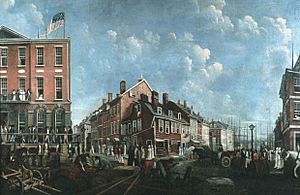Tontine Coffee House facts for kids
The Tontine Coffee House was a very important building in New York City a long time ago. It opened in early 1793 at 82 Wall Street in Manhattan. It was built by a group of people who bought and sold shares, called stockbrokers. They wanted a special place to meet, trade, and send messages.
The coffee house was set up as a "tontine." This was a special way to invest money. Many people put money together, and they would get payments from the investment. The last person alive would get all the money! This helped fund the building. Before the Tontine Coffee House, these traders had signed something called the Buttonwood Agreement in 1792. This agreement meant they would only trade with each other, which helped create a new, organized group of traders.
Contents
A Bustling Hub of Activity
The Tontine Coffee House was one of the busiest places in New York City. People came here to buy and sell stocks, goods, and to do all sorts of business. It was also a place for important political discussions.
More Than Just Coffee
This coffee house was like a club and a meeting room all in one. It hosted many events, such as auctions, big dinners, and dances. After regular hours, people sometimes gambled or traded stocks in ways that were not always seen as honest back then. The coffee house was also where people registered ship cargo.
What made the Tontine special was that everyone, no matter their social class, met there. Rich and poor, important people and everyday citizens, all came together to talk about business and city matters.
What it was Like Inside
An English traveler named John Lambert visited in 1807 and described the scene:
- The Tontine Coffee House was full of people like underwriters (who help with insurance), brokers (who buy and sell things for others), merchants, traders, and politicians.
- They were all busy buying, selling, trading, or insuring things.
- Some were reading, while others eagerly asked for the latest news.
- The steps and balcony of the coffee house were packed with people.
- Auctioneers stood on top of big barrels of sugar or rum, or bales of cotton.
- They shouted loudly, "Once, twice. Once, twice. Another cent. Thank you, gentlemen!"
- Outside, the streets were jammed with carts and wheelbarrows.
- Lambert said, "Everything was in motion; all was life, bustle and activity..." It was a truly lively place!
Political Debates and Conflicts
The Tontine Coffee House was not always peaceful. Political arguments and even fights often broke out there.
French Revolution's Impact
After the French Revolution (a big change in France's government), people in New York had strong feelings. Some supported the British, while others supported the French. Fistfights between these groups happened daily at the Tontine.
An observer wrote that whenever a few people gathered, a quarrel was expected, and crowds would gather around, leading to even more arguments.
A French Liberty Cap
One time, people who supported the French Revolution and the Tammany Hall movement climbed onto the coffee house roof. They placed a French Liberty Cap there. This cap was a symbol of freedom from the French Revolution. Several New York newspapers wrote about this event. Newspapers that supported the French or the Democratic-Republican party praised the people who did it. They encouraged the coffee house owners to let the cap stay on the roof.
Whigs vs. Tories
Another person, Alexander Anderson, wrote in his diary on June 11, 1793, about a conflict at the Tontine:
- "Last night there was an affray at the Tontine Coffee House between Whig and Tory, or to modernize it, aristocrat and democrat."
- This means there was a fight between two political groups: the Whigs (who supported more freedom) and the Tories (who supported the king and tradition).
By December 1793, a New York newspaper called the Columbian Gazetteer complained that "only persons of the same party" would now meet at the Tontine. This shows how divided people had become.
The End of an Era
Trading at the Tontine Coffee House continued until 1817. The amount of trading grew so much that it led to the creation of the New York Stock and Exchange Board (NYSEB). This new group needed a much bigger place to meet. The NYSEB is known as the start of today's New York Stock Exchange, which is one of the largest stock exchanges in the world!
The Tontine Coffee House building changed over time. In 1826, it became a tavern (a type of pub). In 1832, it became a hotel. It even survived the Great Fire of New York in 1835, a huge fire that destroyed many buildings. Finally, in 1855, the old Tontine Coffee House was torn down to make way for a new, larger Tontine coffee house. But even that newer building was demolished in 1905.


